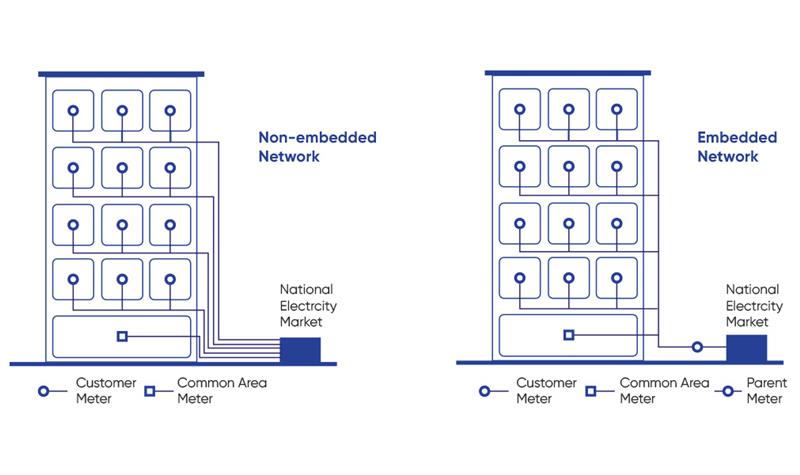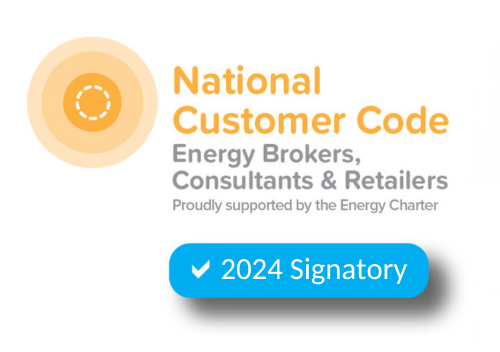If your business operates in a shopping centre, industrial park, or multi-tenant commercial complex, chances are you are part of an embedded electricity network.
While this setup may seem straightforward, it often comes at a cost—especially for large energy users. Embedded network billing structures are typically designed with simplicity in mind, not efficiency. That can mean you are paying more than you need to, without access to competitive rates or control over your energy procurement.
In this article, we will cover:
- What embedded networks are and why they exist
- The regulatory reforms that give your business the right to choose your own energy retailer
- The benefits and trade-offs of switching away from embedded billing
- How we simplify the entire process for large users looking to optimise costs.
What is an Embedded Network
An embedded network is a private electricity setup where an entire site connects to the main grid via a single parent meter. Electricity is then distributed internally to each business tenant, who is billed through child meters managed by the embedded network operator—usually the landlord or a third-party service provider.
This model is common in:
- Retail precincts and shopping centres
- Business parks and industrial estates
- Multi-tenant commercial buildings
- Airports, hospitals, and mixed-use precincts
For large businesses with significant energy loads, this model often lacks pricing transparency, flexibility, and strategic control.
Your Right to Switch: Power of Choice Reforms
The Power of Choice reforms, introduced in 2017, gave commercial tenants the right to opt out of embedded network billing and establish their own market retail energy contract.
These reforms empower your business to:
- Engage directly with a competitive energy retailer
- Be assigned a unique child NMI (National Meter Identifier) for independent billing
- Request that the embedded network operator appoint an Embedded Network Manager (ENM)
- Ensure your metering is NEM-compliant, so external retailers can access usage data and issue accurate invoices
With these mechanisms in place, high-usage tenants can now unlock market-level pricing and procurement strategies once reserved for directly connected sites.

Why Switch Away from Embedded Network Billing?
Embedded billing models often bundle all energy components—supply, usage, network, environmental, and metering—into a single, flat rate. While simple, this structure rarely serves the interests of larger users with high energy demands and cost management objectives.
Pros
✅ Significant Cost Savings
Unbundled pricing enables direct access to competitive wholesale energy rates. Based on historical tenders we’ve run, large users have saved up to 35% by switching away from embedded billing.
✅ Strategic Procurement Options
Gain the flexibility to sign fixed-term contracts for budget certainty or pursue short-term arrangements to remain agile in a volatile market.
✅ Enhanced Billing Accuracy and Support
Partnering with a tier-one retailer means clearer invoices, proactive account management, and faster resolution of billing issues—something many embedded operators can’t offer.
✅ Usage Insights and Data Tools
Most commercial retailers provide online portals that give you access to real-time usage data, invoice history, and forecasting tools—vital for businesses managing peak loads and energy efficiency initiatives.
Cons
⚠️ Two Monthly Invoices
With a market contract in place, your business will receive:
- One invoice from the embedded network operator for network charges (infrastructure/supply)
- One invoice from your chosen energy retailer for electricity, environmental, market, and metering charges
⚠️ Navigating Unbundled Billing
While the shift from bundled to unbundled charges may take some adjustment, it ultimately offers greater transparency and control.
Bottom Line
For large energy users, the benefits of switching far outweigh the complexities. By leveraging your load size and aligning with market pricing, you can significantly reduce your energy costs—while we handle the heavy lifting.
How to Take Control of Your energy Costs
Switching to a market retail contract may sound complex—but for your business, it doesn’t have to be. We manage the entire process on your behalf, so you can unlock savings with minimal time and effort.
Here’s how we do it:
1. ASSESS
We review your current billing structure and compare it to market offers to estimate potential savings.
2. CHECK
We coordinate a site assessment (typically $150–$300) to confirm that your metering is compliant with market rules.
3. TENDER
We run a competitive retailer tender on your behalf, securing tailored offers based on your load profile and risk preferences.
4. SELECT
You choose from our shortlisted offers—no jargon, no surprises. We handle the contract execution.
5. COORDINATE
We work with your retailer and the embedded network operator to create your child NMI and manage the full transition process.
Let’s Review Your Energy Setup
We help large energy users across Australia gain clarity, cut through complexity, and secure better energy deals inside embedded networks.
✅ Independent advice, tailored to large loads
✅ End-to-end project management
✅ Proven results from competitive tenders
Want to find out if you’re overpaying for electricity?
—
Leading Edge Energy can help you secure stable, competitive rates so energy price spikes don’t affect your bottom line.
Let’s chat. Call us at 1300-852-770 or email us at info@leadingedgeenergy.com.au.
You may also sign up for an obligation-free consultation by responding to our form. Click the button below.
We source, analyse, compare and rank commercial, industrial and multi-site energy quotes. Obligation Free.
Chat with one of our experienced consultants today and get the insights your business needs to help manage the risks associated with volatile electricity and natural gas markets. Our energy procurement service is obligation-free and provides a time-saving way of securing lower energy rates from our panel of energy retailers.







